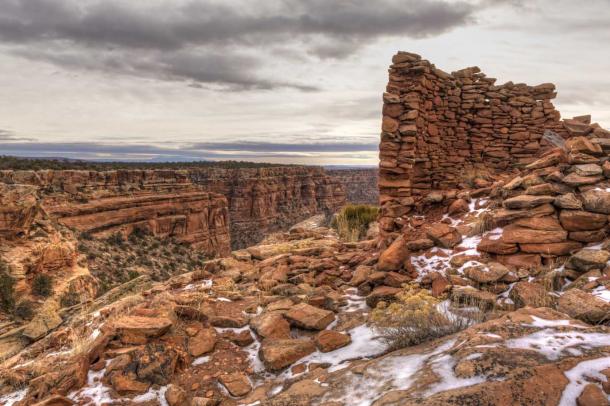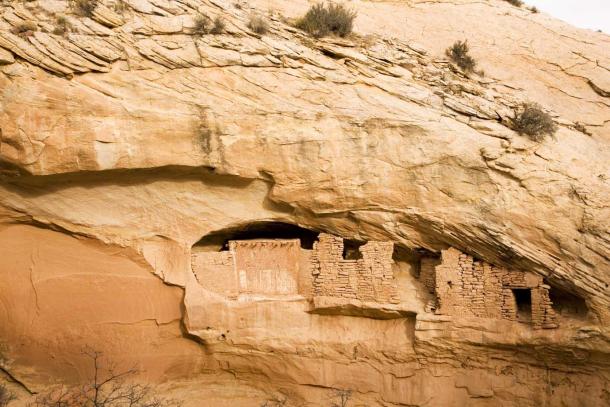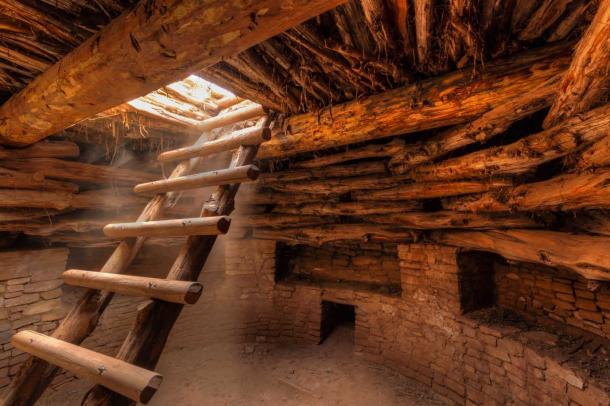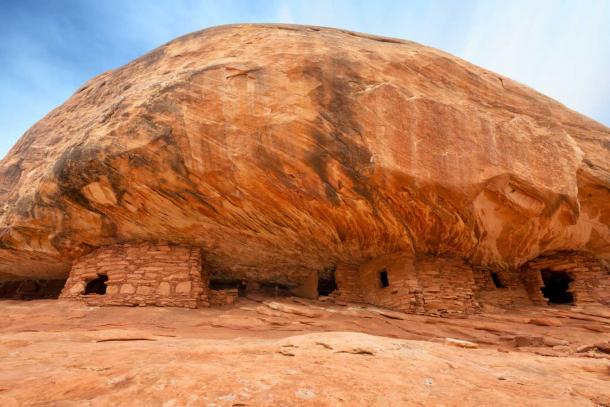The Four Corners region of the United States is a unique place in North America . It is the meeting place of the four corners of Utah, Arizona, New Mexico, and Colorado. With its distinct geographical features, a long and diverse history, and a recognizable regional character, this area really has a lot to offer. The Four Corners and its surrounding regions are all home to a variety of distinct Native American tribes. Here dwell the Zuni, the Ute, the Navajo, and the Hopi people. But the very center of the Four Corners is the home to the Ancestral Puebloans, who are more commonly known by their old name, Anasazi. These natives have long dwelt in these arid landscapes, and have left valuable traces of their lives. One such trace is located in Utah, in the so-called Mule Canyon, where the Anasazi left some very important insights into their ancient way of life.
Earliest Traces of the Anasazi in Mule Canyon
The Ancestral Puebloans are amongst the most recognizable Native American tribes in the southwestern United States. They are also amongst the oldest, with scholars suggesting that the beginnings of their culture emerged as early as 12th century BC, on the bases of previous, similar cultures. They are often called Anasazi, which comes from the Navajo language, and means “ancient enemies”, or “ancestors of our enemies.” This exonym is not accepted by the Puebloans today. The neighboring Hopi peoples called them Hisatsinom, which means “ancient people”. All of these terms give us a crucial insight into the past and the very long presence of this tribe in the Four Corners region.
One of the most recognizable characteristics of the Puebloans in this region is without a doubt their architecture. These tribes expertly adapted to the arid and dry geographical features of the area, skillfully utilizing the natural features of the terrain to create thriving and imposing dwellings. Ancestral Puebloans lived in a wide variety of dwellings, from small pit houses where the majority of the dwelling is below ground, to larger villages and communal dwellings. And it’s these villages that give them their name: Pueblo simply means “village” in Spanish, and is the name given to them by the first explorers.
But the most characteristic of all Pueblo dwellings are their cliff houses. These unique dwellings are perfectly designed to offer both defense from enemies and defense from the elements. With a range of elaborate houses skillfully built into the cliff faces, the Puebloans utilized the very best that this arid region had to offer. The cool surface of the stone and the shade it provided was essential for success in the heat of the summer. One of the great examples of this characteristic Pueblo architecture is located at Mule Canyon in Utah.

The unique architecture of the Ancestral Pueblo peoples found at Mule Canyon in Utah utilized the best the arid region had to offer. ( lightphoto2 / Adobe Stock)
Mule Canyon Architecture of the Pueblo People
Mule Canyon houses the elaborate and surprisingly well-preserved ruins of a small Ancestral Pueblo village. Excavations and the general layout indicate that it was used for general life as well as select religious ceremonies over a long period. This canyon and its sights are located in the southeastern corner of Utah, in the San Juan County, and is the integral part of a large plateau known as the Greater Cedar Mesa. This plateau is well known for the sheer amount of unique canyons, gorges, and cliffs, most of which are dotted with small and large remnants of the Ancestral Pueblo dwellings.
Visiting Mule Canyon, one can quickly spot the distinct Anasazi dwellings nestled between rock faces in the canyon sides. What remains of the houses is quite well preserved, showcasing classic Pueblo building methods. The houses were made from sandstone blocks, connected with mortar made from wet soil mixture. The structures utilize the cliffs for the floor, ceiling and back walls, with only the remaining walls being made from sandstone. These cliffside dwellings made ideal protection from the elements, especially the heat, and generated a good defensive position. Research shows that most of the structures were constructed from sandstone quarried from the most immediate vicinity, another insight into the abundance of material in the region.
Those Pueblo houses at the site that didn’t utilize cliff faces for roofs and floor, were nonetheless well protected. Remains of log frame roofs are still noticeable. They were constructed from a dense mesh of sticks and tree limbs, encased in wet soil mortar. Floors were similarly made from tough, hard-packed soil.

The ruins of an Anasazi cliff house in Utah. ( Kristin Piljay – Danita Delimont / Adobe Stock)
The Industrious Dwellings of the Pueblo Peoples
There are all the elements of a once-thriving Pueblo village at the Mule Canyon site. It consisted of a kiva – a large round building used for religious ceremonies and congregational meetings – a round tower most likely used for defense, and a spacious “room block” consisting of twelve separate rooms. This last feature was one of the crucial protective elements in a Pueblo village: the room block was used for storage and shelter, especially in bad weather.
Here we need to note a well known fact – that the Ancestral Puebloans naturally spent a lot of their time out of doors, and that the houses and dwellings were mainly used for protection. The kiva is a common feature in almost all Pueblo sites and is also visible amongst other Native cultures as well. It had a deep religious significance and was the place for many ceremonies. It also housed community meetings and had a distinct round shape.
The tower is however the most enigmatic feature of Pueblo architecture. Round towers and their remains are seen in several Pueblo villages. Some scholars speculate that their purpose might have been defensive, while others propose that they were simply another means of grain and food storage. Another distinct possibility is its use as an observatory, for ceremonial purposes. Ancestral Puebloans had a solid grasp of the celestial bodies, and many of their dwellings show a connection to this aspect of their distinct culture.
Extensive research has shown that the dwellings in the Mule Canyon were occupied between the 11th and 12th centuries AD. During the explorations, researchers discovered one feature that could be unique for this part of Utah, as it is rarely observed in other Pueblo sites. It is a small network of tunnels which connected the kiva dwelling with both the round tower, and the room block as well. These tunnels – now permanently sealed – were used as a protective passage around the site, but why exactly the Puebloans constructed them is not known. Nevertheless, they are a rarity.
Research shows a long period of habitation in the Mule Canyon. What is present today is simply the last phase of this habitation period, built on top of a previous Pueblo occupation which possibly dates to the 9th and 10th centuries AD. Remains from this earlier period are scarce and more crude, including a kiva made entirely from earth, and some small pit houses. Even so, these remains are crucial as they show that the Mule Canyon location was strategically important, and a good place for life overall.

The Edge of the Cedars museum in Blanding, Utah, is home to a restored kiva, a large round building which was used by the Ancestral Pueblo peoples for religious ceremonies and congregational meetings. ( lightphoto2 / Adobe Stock)
House on Fire: Iconic Red Sandstone Remains at Mule Canyon
One of the iconic features of the Mule Canyon Pueblo complex, is commonly called the “House on Fire” by the hikers and researchers alike. House on Fire is located in the South Fork of Mule Canyon, and continues to be a “fan favorite” spot for travelers. Its state of preservation and its beauty are incredibly inspiring, providing a unique insight into the traditional life of the Ancestral Puebloans. The House on Fire gets its nickname due to the distinct coloring of the red sandstone above it – when hit by the sun during the day, these rocks have unique patterns that resemble flames and smoke, coming from the walls of the house below them.
The House of Fire in the Mule Canyon is one of the prettiest Pueblo house remains. It is still one of the favorite spots for photographers, considered the iconic representation of Anasazi architecture. But more importantly, its state of perfect preservation provides insight into the old Pueblo building methods, including the precision and the durability of the windows and walls. It remains one of Mule Canyon’s most visited locations.
When the central dwelling site in the Mule Canyon was abandoned, sometime in the 12th century AD, several sections were gradually eroded by the elements. However, thanks to the quality of Pueblo construction methods , the majority of the ruins were preserved for posterity. Still, we need to note the fact that certain preservation attempts were made in modern times, in order to keep the Mule Canyon ruins standing for generations to come.
Wind and rain – heat too – are important threats for these ruins. The walls were stabilized by replacing and strengthening the loose stones and mortar layers, in sectinos that were crucial for the overall stability of the walls. During this process, the preservation team took great care to precisely match not just the color and the original layout, but also to follow the traditional building methods of the Ancestral Pueblos. Thanks to this attention to detail, the sites at Mule Canyon are safe for all visitors, and also remain true to their appearance when they were originally discovered.
Today, the Mule Canyon ruin complex is under the administration and protection of the US Department of Interior’s Bureau of Land Management. It remains one of Utah’s most important archaeological and historical sites, and a place of popular interest. But most importantly, it is an invaluable piece of the Ancestral Pueblo heritage.

The iconic red sandstone remains of House on Fire at Mule Canyon. ( kojihirano / Adobe Stock)
The Seven Towers: Observing the Stars or Defending the Pueblo Peoples?
We mentioned House on Fire as one of the most popular locations in the Mule Canyon – but it is not the only one. The Cave Towers is another secluded, often overlooked, site that speaks of the enigma of the Ancestral Puebloans. The site is also known as the “Seven Towers Ruin”, and is perched high above ground, on the rim of the Mule Canyon. Although fragile, the Mule Canyon Towers are nevertheless very impressive. The remains of seven towers are perched on the very edge of the Mule Canyon’s highest rim, offering a commanding view of the surroundings, and some of the most picturesque views overall.
The exact nature of these towers is still largely debated. Their purpose might have been defensive: their positioning and the strategic view of the surrounding lands could indicate this. What is more, these towers are roughly a mile away from the round tower of the Mule Canyon ruins and the two locations are within sight of each other. This could give them a communication role, again for defensive purposes. However, others propose that they had a ceremonial and observatory purpose, as they also offer a clear view of the starry skies above.
They are generally said to date back to around 1250 AD, while experts agree they are the best location of studying the tower structures in the entire Cedar Mesa Plateau. However, they are in a state of disrepair and are very fragile, so special care is advised for all visitors. Below the towers and the canyon rim, the cliff faces are again dotted with a variety of small, somewhat crude Pueblo dwellings. For those exploring the Mule Canyon Ruins, a visit to the Seven Towers can be the perfect end to a day of exploring the area.
;
Demise or Assimilation of the Ancestral Puebloans?
There is still a lot that needs to be learned about the Ancestral Pueblo Anasazi. Much of their history and heritage is lost to time, due to the fact that – like most native tribes – they did not have a formal system of writing and no written records of their history and culture were left behind. It is archaeology that helps us to piece together the puzzle of these ancient peoples. Locations such as the Mule Canyon remain a big and important glimpse into their past.
What we know is that the Ancestral Pueblos experienced a sudden decline and disappearance. Around the late 1300s AD, there was an abrupt end to the building of villages such as the one in Mule Canyon. The nature of their demise is unknown, but scholars agree that they did not vanish as a people. Instead, it is much more likely that they were assimilated into larger groups, or perhaps migrated further south. It is now generally agreed that the Hopi Indians of today, as well as the Jemez, Zuni, Zia, and Sandia Indians of Arizona and New Mexico, are partially descended from the Ancestral Puebloans.
Even so, there is no doubt that these ancient peoples were skilled in architecture and in exploitation of the terrain they lived in. Even though the geography of the Four Corners region is arid and inhospitable, the Ancestral Pueblos managed to make the best of it and to thrive, leaving behind them an incredible wealth of remains.
Top image: The House on Fire ruins are one of the highlights for visitors to Mule Canyon. Source: traveller70 / Adobe Stock
Related posts:
Views: 0
 RSS Feed
RSS Feed

















 January 22nd, 2021
January 22nd, 2021  Awake Goy
Awake Goy 


 Posted in
Posted in  Tags:
Tags: 
















